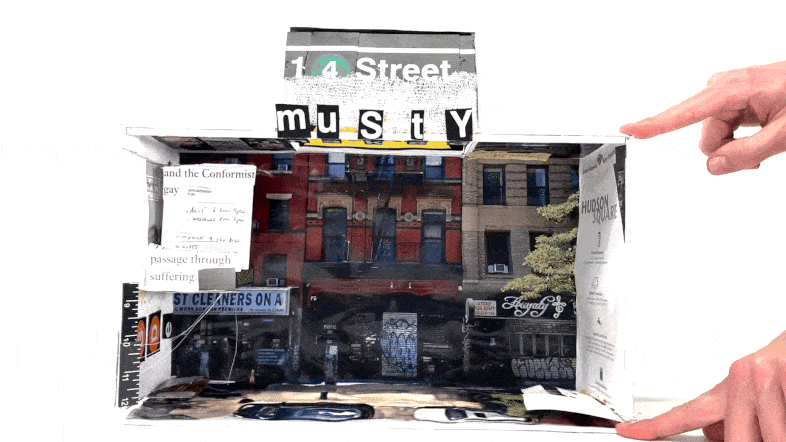 |  |  |
|---|---|---|
 |  |  |
 |  |  |
 |  |  |
 |  |  |
 |  |  |
 |  |  |
 |  |  |
The Non-Heteronormative City
EXPLORING QUEER HISTORIES AND FUTURITIES IN NEW YORK
The non-heteronormative city used framing from José
Esteban Muñoz’s “Cruising Utopia” to encourage us to look to the past to envision queer futures. We began the semester with emotional oral interviews of queer people across generations who inhabited the villages at various states of their evolution. We proceeded to map, sketch, and model our understandings of the now all but lost queer spaces in our very backyards before moving to other sites around New York City to imagine contemporary locations for non-heteronormative ways of being. The final exhibition synthesized our semester with unconventional materials and profoundly personal collective work.
My wistful recollections of a bygone Manhattan are made of someone else’s dreams. I imagine bodies braided on a darkened dance floor, crumbling piers preening into the Hudson, artists and actors experimenting with forbidden forms.
I see love, expressed unconditionally. I see sex, expressed lovingly.
I see a healthy, hearty meal shared with friends. I see performances free, funny, and fearless. I see whimsical displays of collective artistry.
I see water and wood and warmth.
It’s a fantasy to believe that these times were any sort of Eden. What to draw from someone else’s dreams? What to draw from their nightmares? An apocalyptic utopia, I wade through waters I will never know to create a world I will never see. There is a horizon, but it evades my grasp. Too many buildings are in the way. There are too many buildings. There are too many ways.
Away. Away from the four facades of Tompkins, the shuttered Pyramid Club, the gutted bones of Stonewall.
In the forgotten western corner of the Rockaways, we walked the windy beach in search of a spark. If Manhattan holds only layers of buried history, Riis Beach holds a landmark almost lost, clinging to meaning in its final days with the help of well-intentioned activists fighting an uncaring bureaucracy.
The hulking four stories of the dilapidated Neponsit Beach Hospital sit fenced off awaiting their fate. Wisps of rainbow fabric weave among barbed wire and chain link, trailing off unceremoniously from a small memorial to a beloved local drag queen. Spray paint on the roof declares: “QUEER + TRANS POWER” and “KNOW YOUR POWER.” The few people braving this early spring beach day stroll by, save one man set up with a tent at his usual spot. In the summer, hundreds of bodies like his will flood this stretch of beach, living up to its designation of “queer.” Right now, it is quiet. Contemplative. Haunted. Waiting. There is palpable pain in the inevitability of change to come, once the hospital is fully razed. There is nobody here to voice that pain.
The power, the profound resilience of the queer community, lies not in place. Not concretely. We have accepted that a place can only be ours for so long. We live our lives, leave our marks. We love. We leave. The buildings come down in spectacular fanfare. Our stories, our rituals, our memorials—scrubbed from the corporeal, relegated to myth and story. We walk further along the beach, in search of a new forgotten place to call our own. We tell the old stories. We make new ones. We live our lives, leave our marks. We love.
We leave.
WHAT
Community engagement studio
WHERE
New York City
WHEN
Spring 2023
PARTNERS
David d'Olimpio
Habiba Elnagdy
Stan Walden
INSTRUCTORS
Brian McGrath
